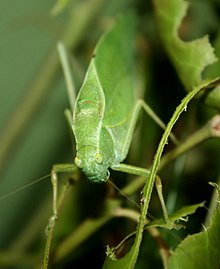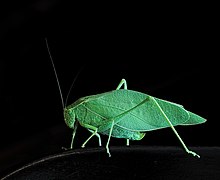en
names in breadcrumbs


The Lesser Anglewing Katydid (Microcentrum retinerve) is found in the tops of broad-leaved trees in the eastern U.S. from Long Island to southern Illinois and easternmost Texas (excluding southern Florida). Like Greater Anglewings, they may be attracted to lights. The song of the Lesser Anglewing consists of two or three short rattles in sequence, often phrased in such a way that each rattle sounds like a comment in response to the preceding one.
The Lesser Anglewing is more strictly arboreal than the similar Greater Anglewing (M. rhombifolium). The male Lesser Anglewing has a contrasting dark brown stridulatory area and the front edge of the pronotal disc is smooth and lacks a tooth (in the male Greater Anglewing, this area is green like the surrounding wing and the front edge of the pronotal disc is slightly wavy with a central tooth pointing toward the head). The short, upward-bent ovipositor of the female Lesser Anglewing has a bluntly rounded tip (in the Greater Anglewing, the tip is less rounded, appearing almost as if it were snipped straight across at the tip). In the Lesser Anglewing, the cerci curve gently inward, whereas in the Greater Anglewing they are more sinuous.Lesser Angle-wings are generally smaller than Greater Anglewings (44 to 53 mm in length versus 52 to 63 mm). The California Anglewing (M. californicum) of California andArizona is similar in size (41 to 51 mm inlength) and also lacks the pronotal tooth. Its song is a brief two-part lisp repeated at an interval of around 2.5 seconds.
(Capinera et al. 2004; Himmelman 2009)
Microcentrum retinerve is a species in the family Tettigoniidae ("katydids"), in the order Orthoptera ("grasshoppers, crickets, katydids").[1][2] A common name for Microcentrum retinerve is "lesser angle-winged katydid".[3] Microcentrum retinerve is found in North America.[2]
Microcentrum retinerve is a species in the family Tettigoniidae ("katydids"), in the order Orthoptera ("grasshoppers, crickets, katydids"). A common name for Microcentrum retinerve is "lesser angle-winged katydid". Microcentrum retinerve is found in North America.


